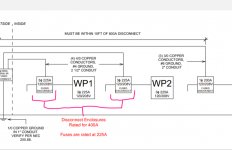Right, for compliance with 240.21(B)(1)(1)(b), we have two choices, and can pick either one.
So what is the difference between the second option referring to "the rating of the overcurrent protective device at the termination of the tap conductors" and 240.21(B)(2)(2) referring to "the rating of the single circuit breaker or single set of fuses on which the tap conductors terminate"?
To mean, those mean the same thing. I.e. 240.21(B)(1)(1)(b) is giving you all the options present in 240.21(B)(2)(2), plus whatever options the first clause in 240.21(B)(1)(1)(b) is meant to also offer.
Cheers, Wayne


